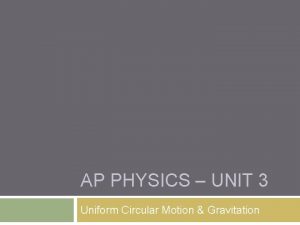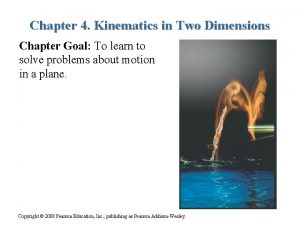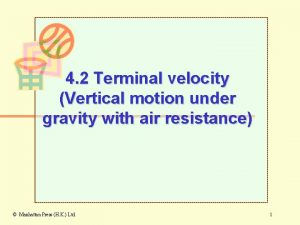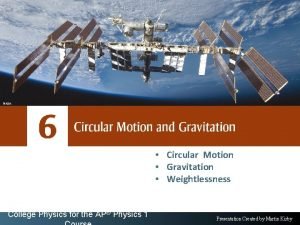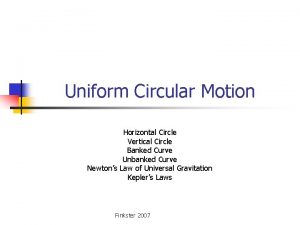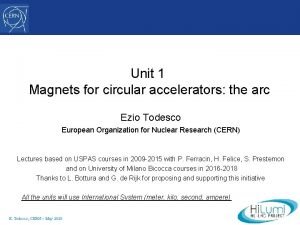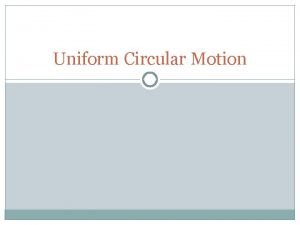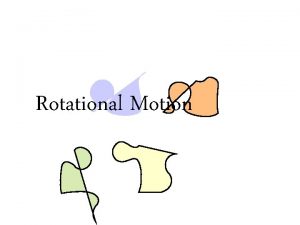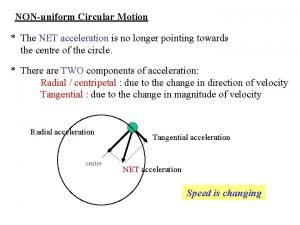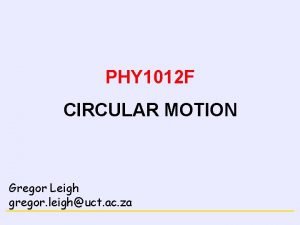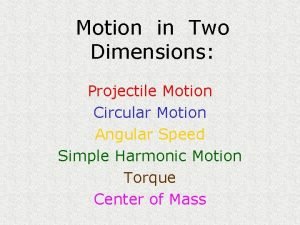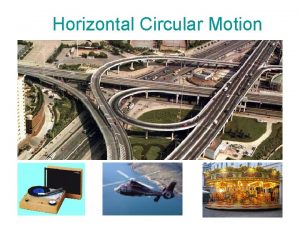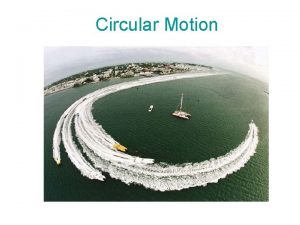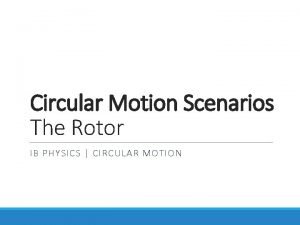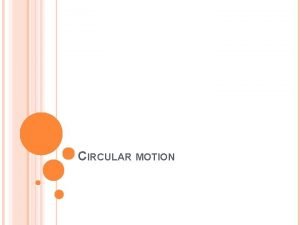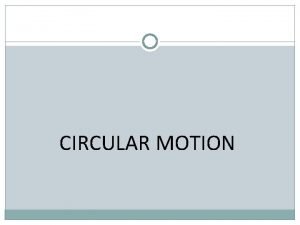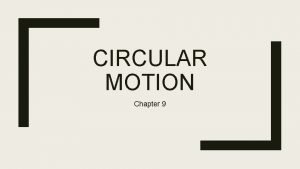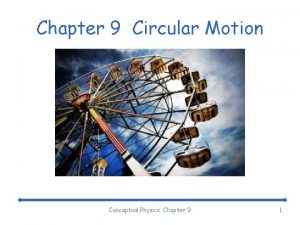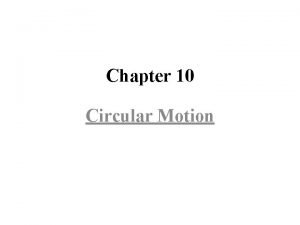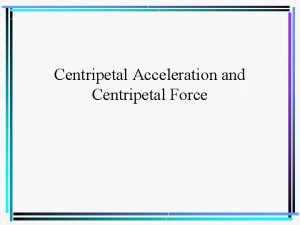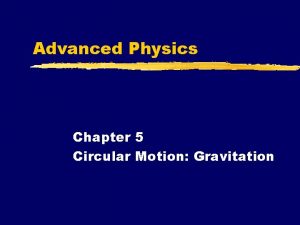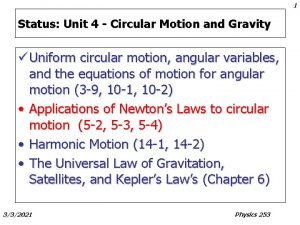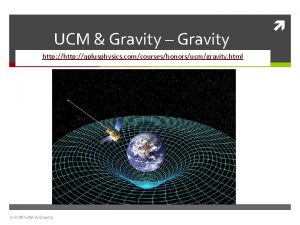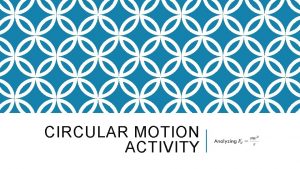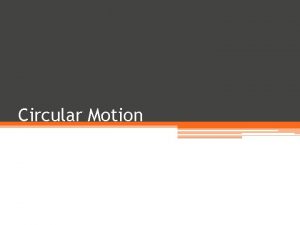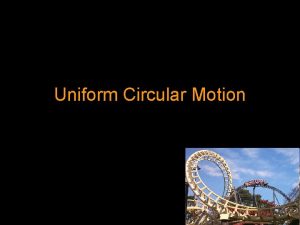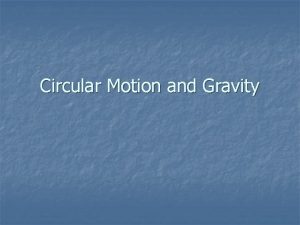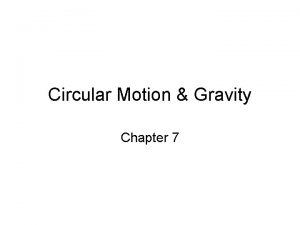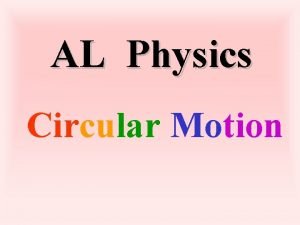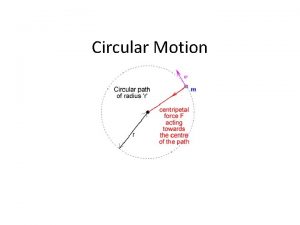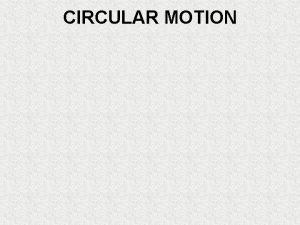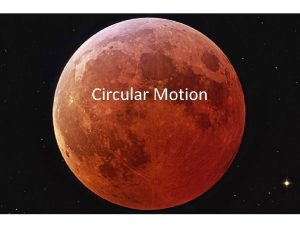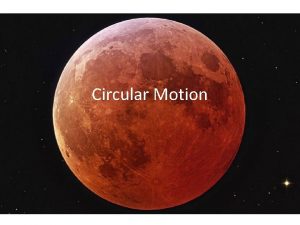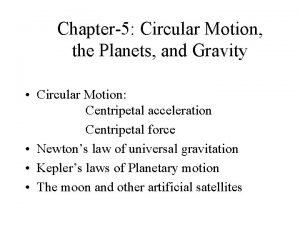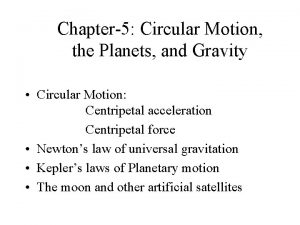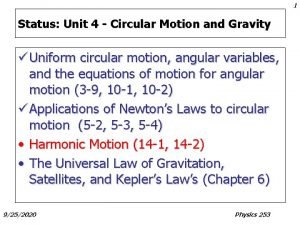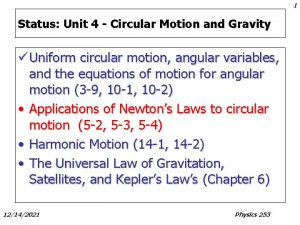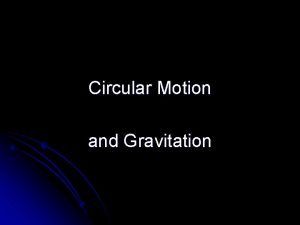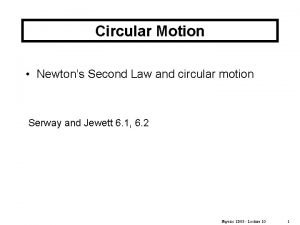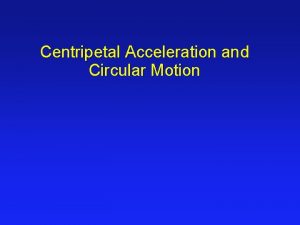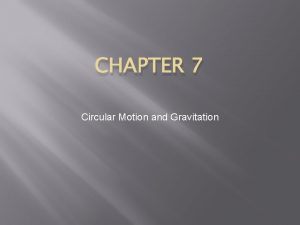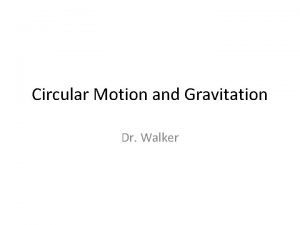1 Status Unit 4 Circular Motion and Gravity


























- Slides: 26

1 Status: Unit 4 - Circular Motion and Gravity ü Uniform circular motion, angular variables, and the equations of motion for angular motion (3 -9, 10 -1, 10 -2) ü Applications of Newton’s Laws to circular motion (5 -2, 5 -3, 5 -4) ü Harmonic Motion (14 -1, 14 -2) • The Universal Law of Gravitation, Satellites, and Kepler’s Law’s (Chapter 6) 11/21/2020 Physics 253

2 11/21/2020 Physics 253

3 The Universal Law of Gravitation • Explained the motion of the • Let’s try to follow Newton’s planets and acceleration of logic gravity. – Sine SF=ma there must be a force associated with the • Along with the three laws of acceleration objects feel motion, one of Newton’s anywhere on the surface of greatest contribution to science. the earth. • Published in the Principia – The ubiquitous nature of this (1687). acceleration led Newton to conclude that the Earth itself • Led to a fully deterministic exerts the gravitational force. description of the mechanical – The observation that gravity universe. acts at the surface, at the tops • The deterministic nature not of trees and on mountains “overturned” until the quantum suggests the force also acts on revolution of the 20 th century. the moon! (Here is where you can insert the apocryphal story of the falling apple…) 11/21/2020 Physics 253

4 Action at a Distance? • Newton’s logic led to the gravitational force “acting at a distance”. • Common sense seems to suggest that contact is require forces to exert themselves. This is true of friction, the normal force, tension… • This was hard to accept at the time and with the quantum revolution a solution was at hand… • And it’s still not fully resolved! 11/21/2020 Physics 253

5 The Form of the Universal Law of Gravitation • On the surface we know empirically that the acceleration of gravity is g= 9. 80 m/s 2. • Since the moon moves in circular orbit we can us a=v 2/r to calculate a. R~g/3600. • But the moon is 60 earth radii from the center of the earth. • These last two observations suggest that the force of gravity between two objects is inversely proportional to the distance squared or 11/21/2020 • And the 2 nd law clearly states that at the Earth’s surface the force of gravity is proportional to the mass of the falling body, generalizing this to any distance we have, Physics 253

6 • The third law requires that each force have an equal and opposite force. This suggests that the earth feels a force as well and by symmetry proportional to the earth’s mass: • Newton also observed that the force holding the planets in their orbits varies with the inverse square of their distance to the sun and another manifestation of the gravitational force. • This naturally leads to the idea that all objects exert such a force on one another. 11/21/2020 • The law of universal gravitation: Every pair of objects in the universe attract each other with a force proportional to the product of their masses and inversely proportional to the square of the distance between them. The forces act along the line joining the two objects. • The constant of proportionality is experimentally determined but is the same for all objects. Physics 253

7 The Vector Form of Universal Gravitation 11/21/2020 Physics 253

8 Using the calculus and symmetry Newton showed that for a spherical object the force of gravity “emanates” from the center. See Appendix C for a rigorous derivation. Note all of axis components cancel 11/21/2020 Physics 253

9 On the Surface of Earth • Applying the equation of Universal Gravitation to an object of mass m on the surface of the earth – m 1 = m. E – m 2 = m – r = r. E • But from our earlier observations and lessons we also know that the force is equal to mg 11/21/2020 • Thus g is determined by the universal constant and the mass and size of the earth. Physics 253

10 Determining the Universal Constant, G • Must be small because we don’t feel it in our everyday experiences. • First measured by Henry Cavendish using a torsion balance. • G=6. 67 x 10 -11 Nm 2/kg 2 11/21/2020 Physics 253

11 A chemist and physicist - he was really after the mass of the earth (to 1%) 11/21/2020 Physics 253

12 Magnitudes • What’s the gravitational force between – two 100 kg individuals sitting on a bench 0. 5 meter apart? – the earth and a 100 kg person? – the earth and the moon? – the sun and the moon? 11/21/2020 Physics 253

13 The change on top Mt. Everest • Estimate the effective value of g at the peak of Mt. Everest, 8, 848 m above sealevel. • Which is about 0. 3% lower than at sealevel. Something easily measurable with a sensitive scale. 11/21/2020 Physics 253

14 The Effect of the Earth’s Rotation on g • Because of centripetal acceleration g is a bit different at the pole and the equator. • Consider the two freebody diagrams at the right showing a mass hanging from a spring scale. • At the north pole the 2 nd law gives: mg-w=0 and w=mg. • However at the equator there is also centripetal acceleration as the mass rotates around the center of the earth. The 2 nd law gives: mg-w’=mv 2/r. E. • This can be reorganized to w’=m(g-v 2/r. E) 11/21/2020 Physics 253

15 • Which can be interpreted as an effective g’=g-v 2/r. E • The change in the acceleration of gravity is thus just v 2/r. E. • The velocity is given simply by v=2 pr. E/T, substituting we find Dg=g-g’= 4 p 2 r. E/T 2 • And using – r. E=6. 38 x 106 m – T = 1 day = 8. 64 x 104 s 11/21/2020 • Plug and chug gives: Dg= 4 p 2(6. 38 x 106 m)/(8. 64 x 104 s)2 =0. 0034 m/s 2. • Note: – This is about a 0. 03% reduction and an order of magnitude less that the effect on Mt. Everest. – Because the centripetal acceleration depends on the distance from the axis of rotation it varies with latitude. This also means the acceleration vector does not point directly downward except at the equator and pole! Physics 253

16 Satellites in Circular Orbits • Now for a bit of fun! • With our tools & concepts we can study some of the characteristics of satellites. • If an object is to stay in circular orbit around the earth a centripetal force must continually turn the velocity vector, gravity! • Using the 2 nd Law and setting the mass of satellite to m, we find a precise relationship between the velocity and the radius of a satellite’s orbit: 11/21/2020 • One speed for a fixed radius. • v inv. prop to 1/sqrt(r). • v same for any mass Physics 253

17 The Essence of Orbiting Satellites • The tangential velocity is what keeps the object in orbit. • The centripetal acceleration provided by gravity merely turns this velocity into the uniform circular path. • The relationship between velocity, G, the mass of the earth and r gives us the precise interplay between the kinetic and geometric variables. • The result applies to any astronomical system. Just replace m. E with the mass about which an object is orbiting. • We could use it to study the motion of the planets around the sun if we use the solar mass or of satellites about Jupiter if we use Jupiter’s mass. 11/21/2020 Physics 253

18 Jupiter and its moons (from left to right) Ganymede, Europa being eclipsed, and Callisto. Galileo Galilei first observed the moons of Jupiter on January 7, 1610 through a homemade telescope 11/21/2020 Physics 253

19 Example: Hubble Telescope • Determine the speed of the Hubble space telescope orbiting at a height of 596 km above the earth’s surface. • To start we just need to recognize that the radius of the orbit is equal to the radius of the earth plus the height above the surface and apply our new found equation. 11/21/2020 Physics 253

20 Example: A Distant Galaxy • By observing light from M 87 with the Hubble telescope astronomers have determined that the orbital speed at a distance of 5. 7 x 1017 m is 7. 5 x 105 m/s. What is the mass, m, of the object at the center of this galaxy? • Here we just manipulate our equation to solve for the mass. 11/21/2020 Physics 253

21 11/21/2020 Physics 253

22 Example: Characterizing Distant Satellites • A satellite of mass m=5850 kg is in circular orbit 4. 1 x 105 m above a planet of radius 4. 15 x 106 m. The period of the orbit is 2 hours. What is the true weight of the satellite when at rest on the surface of the planet? • This is an interesting problem. We need to use our equation to find the mass of the planet and the use the gravitational law to measure the force or weight at the surface. 11/21/2020 Physics 253

23 Synchronous Orbits • Any satellite in an orbit locked over a specific location on earth (synchronous orbit), must revolve around the earth’s center at the same angular velocity as the earth’s surface. • This only happens at a specific velocity and at a specific radius. • Let’s be a bit more quantitative. 11/21/2020 Physics 253

24 The Radius of a Synchronous Orbit • What is the height above the earth’s surface at which all synchronous satellites must be placed in orbit? • Our last result gives the relations ship between the radius and the period of an orbit. • If we simply set the period equal to one day we have radius of a synchronous orbit. 11/21/2020 Physics 253

25 Schedule • Next Quiz: Wednesday March 7 th • Units 3 and 4: – Force and Laws of Motion – Circular Motion and Gravity. • Homework and Extra Credit for Units 3 and 4 due before the test. 11/21/2020 Physics 253

26 Quiz Details • • • Same format as first quiz Calculators OK, but not necessary Total of 50 points – 4 multiple choice @ 5 pts each – 3 problems @ 5, 10, 15 points. • Friday you’ll hear what is on the test! 11/21/2020 Physics 253
 Gravity for dummies and dummies for gravity equations
Gravity for dummies and dummies for gravity equations Ap physics unit 3 circular motion and gravitation
Ap physics unit 3 circular motion and gravitation What is the value of g on planet exidor?
What is the value of g on planet exidor? Tangential speed
Tangential speed Lesson 4 gravity and motion lesson review
Lesson 4 gravity and motion lesson review Vertical motion under gravity
Vertical motion under gravity Which lines create length and height in a hair design
Which lines create length and height in a hair design Ap physics 1 circular motion and gravitation
Ap physics 1 circular motion and gravitation 3.f horizontal circles
3.f horizontal circles Relativistic circular motion
Relativistic circular motion Two equal mass rocks tied to strings
Two equal mass rocks tied to strings Circular motion equation
Circular motion equation Non uniform circular motion
Non uniform circular motion Non uniform circular motion
Non uniform circular motion Acceleration formula in circular motion
Acceleration formula in circular motion Circular motion on banked road
Circular motion on banked road Two examples of circular motion
Two examples of circular motion Ib physics
Ib physics Circular motion formulas
Circular motion formulas Circular motion formula
Circular motion formula Circular motion definition
Circular motion definition Circular motion conceptual physics
Circular motion conceptual physics Chapter 10 circular motion
Chapter 10 circular motion Vertical centripetal force
Vertical centripetal force Chapter 5 circular motion gravitation
Chapter 5 circular motion gravitation Circular motion
Circular motion Ucm gravity
Ucm gravity

